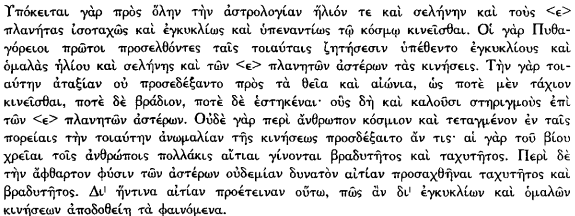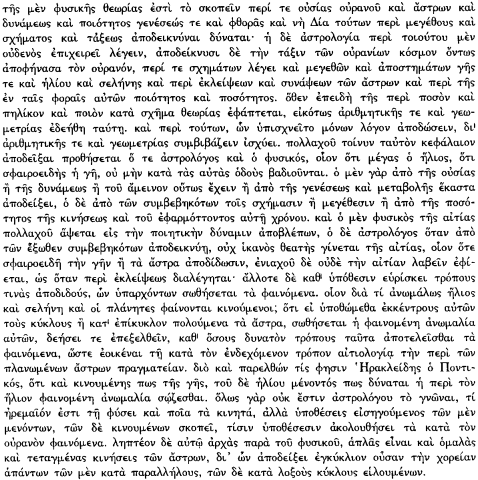No CrossRef data available.
Article contents
Celestial Dynamics at the Crossroads: Proclus' Reassessment of Plato in the Light of Empirical Science
Published online by Cambridge University Press: 08 May 2015
Extract
The imbuing of the visible world with Reason necessitated for Plato an intermediary realm in heaven where physical bodies are seen to move with uniform and circular motion. Such an expression of celestial order was in keeping with Greek physical thought, and was adopted in turn by the later astronomers as they sought to account for apparent irregularities displayed by those very bodies in the heavens. The sophistication of the Greek scientific endeavour and especially Hellenistic astronomy led, however, to an ever increasing body of evidence which ultimately refused reconciliation with the mathematical constructs proposed to maintain the presumed uniformity.
- Type
- Research Article
- Information
- Copyright
- Copyright © Australasian Society for Classical Studies 2002
References
1 ![]()
2 ![]()
 (Unless otherwise stated, all translations are by Robert Hannah.)
(Unless otherwise stated, all translations are by Robert Hannah.)
At Laws 897d3-898b3, axial rotation is equated with the motion of reason, which is described as most like movement in one place around a centre: both motions move ‘in the same way and manner, and in the same place and about the same place, and in relation to the same, and according to one law and one order’ (
![]()
![]() 898a8–b1).
898a8–b1).
3 All motion must have as its source a self-moving thing, and this is precisely the definition of Soul (cf. Laws 896a1-5).
5 Zeyl, D.J., Plato: Timaeus (Indianapolis and Cambridge 2000) xlvGoogle Scholar, emphasises the fact that the circle of the Same and that of the Different intersect at ‘a considerable angle’. This angular displacement, when combined with contrary motion, is crucial to Plato's understanding of how the planets might wander.
6 Cf. Furley, D., ‘Cosmology’ in Brunschwig, J. & Lloyd, G.E.R. (eds.) Greek Thought: A Guide to Classical Knowledge (Cambridge 1987) 285Google Scholar: ‘Sameness no doubt symbolises the regularity of [the planetary] motions, Difference their independence from the stars and from each other, and Existence their eternity.’
7 There is here a well-known contradiction with the stance taken in Republic 529c7–530c5. At Rep. VII. 529c7–d8Google Scholar, Socrates explains that ‘[I say that] the embroideries in heaven, since they are worked in the visible world, are to be considered to be the most beautiful and perfect of such things, but very much fall short of the true realities—of the movements, by which essential speed and essential slowness, in true number and in all true forms, are moved in relation to each other and by which they move what is essentially in them—those true realities, which are to be comprehended by reasoning and intelligence, but not by sight. … Therefore, … we must use this embroidery about heaven as a model for our study of these realities. …’ (Following the analysis of the Greek by Adams, J., The Republic of Plato (Cambridge 1902) II, 128-29, 186-87Google Scholar: ![]()

![]() ) Recently, however, Gregory, A., Plato's Philosophy of Science (London 2000) 121Google Scholar, has attempted to show that ‘the Timaeus, like the Philebus, Laws and Epinomis but unlike the Phaedo, Republic and Politicus advocates a stable cosmology and motion for the visible heavens which is regular, circular and amenable to exact mathematical analysis. … The cosmos is no longer thought of as turning on a pivot, contra the Republic and the Politicus, and the cosmos now has an immortal soul, against being soulless in the myth of Er and having a mortal soul in the second phase of the Politicus myth.’
) Recently, however, Gregory, A., Plato's Philosophy of Science (London 2000) 121Google Scholar, has attempted to show that ‘the Timaeus, like the Philebus, Laws and Epinomis but unlike the Phaedo, Republic and Politicus advocates a stable cosmology and motion for the visible heavens which is regular, circular and amenable to exact mathematical analysis. … The cosmos is no longer thought of as turning on a pivot, contra the Republic and the Politicus, and the cosmos now has an immortal soul, against being soulless in the myth of Er and having a mortal soul in the second phase of the Politicus myth.’

9 On Geminus, see Neugebauer, O., A History of Ancient Mathematical Astronomy ii (Berlin, New York 1975) 578-81CrossRefGoogle Scholar.
10 
Cf. SirHeath, Thomas, Aristarchus of Samos, the Ancient Copernicus: A History of Astronomy from Aristarchus together with Aristarchus' Treatise on the Sizes and Distances of the Sun and Moon (Oxford 1913) 269Google Scholar.
11 Wasserstein, A., ‘Greek Scientific Thought’, Proceedings of the Cambridge Philological Society 188 n.s. 8 (1962) 52Google Scholar. For Plato's reconciliation of observation with a priori assumptions see Vlastos, G., Plato's Universe (Oxford 1975) 53–4Google Scholar.
12 The full passage is: ![]()
 (Simplicius, , In Cael. 488.18–24Google Scholar). Cf. Sambursky, S., The Physical World of the Greeks (London 1956) 59Google Scholar.
(Simplicius, , In Cael. 488.18–24Google Scholar). Cf. Sambursky, S., The Physical World of the Greeks (London 1956) 59Google Scholar.
13 Wasserstein (n.11) 52.
14 Dicks, D.R., Early Greek Astronomy to Aristotle (Bristol 1970) 153Google Scholar.
15 de Santillana, G., The Origins of Scientific Thought from Anaximander to Proclus, 600 B.C. to 300 A.D. (Oxford 1924) 243Google Scholar.
16 See Ross, W.D., Aristotle's Metaphysics: A Revised Text with Introduction and Commentary (Oxford 1924) 383Google Scholar for a summary of these motions. Not primarily intended for greater accuracy, Aristotle's modifications sought rather to make the theory compatible with his ideas of substance and cause.
17 Sambursky (n.12) 60.
18 Sambursky (n.12) 62.
19 See Lloyd, G.E.R., Greek Science after Aristotle (London and New York 1973) 61–65, and 62 fig. 6Google Scholar for an explanatory diagram. From the late fifth century B.C.—the dramatic date of the Timaeus—astronomical observation in Athens had shown that the astronomical seasons were not of equal length: cf. Dicks (n.14) 88; Newton, R.R., Ancient Planetary Observations and the Validity of Ephemeris Time (Baltimore and London 1976) 164-66Google Scholar.
20 Dijksterhuis, E.J., The Mechanization of the World Picture (Oxford 1961) 56Google Scholar.
21 See Dicks (n.14) 183-85 for a detailed explanation.
22 Cf. Dijksterhuis (n.20) 57; Sambursky (n.12) 62.
23 Sambursky (n.12) 63; Lloyd (n.l9) 65-66, and 62 fig. 5, 66 fig. 9 for explanatory diagrams.
24 The full passage is:

25 Sambursky (n. 12) 4. Sambursky perhaps slightly overstates his case, insofar as his notion of the cosmos as ‘a single orderly unit1 captures at best only two of Geminos’ first principles—simplicity and orderliness—omitting, or underemphasising, that of uniformity.
26 See Toomer, G.J., Ptolemy's Almagest (London 1984)Google Scholar for full commentary.

29 Taub, L., Ptolemy's Universe: The Natural Philosophy and Ethical Foundations of Ptolemy's Astronomy (Chicago and LaSalle, Illinois 1993)Google Scholar.
30 Taub (n.29) 113.
31 Trans. Sambursky, S., The Physical World of Late Antiquity (New York 1962) 145Google Scholar.
32 Trans. Sambursky (n.31) 142.
33 Sambursky (n.31) 143.
34 Taub (n.29) 113.
35 Sambursky, S., ‘Plato, Proclus and the Limitations of Science’ in Journal of the History of Philosophy 3 (1965) 1CrossRefGoogle Scholar.
36 de Santillana (n.15) 313.
37 Sambursky (n.35) 8.


This translation preserves the Ms reading for 3.57.2, in contrast to Festugière, A.J., Proclus: Commentaire sur le Timée (Paris 1967) III, 79Google Scholar.

Cf. Sambursky (n.35) 8.
40 Sambursky (n.35) 9 believes that, for Proclus, the planetary motions represent ‘a symbolic expression of the irrational streak in nature whose existence he regarded as an inexorable fact.’ If this is so, then this irrationality at the planetary level is presumably to be distinguished from the concept of an irrational soul being responsible for disorderly motion in the cosmos—a concept promoted by Plutarch and Atticus, but rejected by Proclus, using arguments from Porphyry and Iamblichus (In Tim. 1.381.26–393.13 passimGoogle Scholar).
41 Proclus clearly believes the sphere of fixed stars to move with the uniform motion of the Same. This is nowhere better demonstrated than in his indignant rejection of the precession of the equinoxes: In Tim, 3.125,4-16Google Scholar; cf. Festugière (n.38) IV, 161; Sambursky (n.31) 148.


44 ![]() It is tempting to think that an orbit similar to that illustrated in Lloyd (n.19) 66 fig. 9 is what Proclus has in mind, but we must remember also that he regards the epicyclic theory as too complex.
It is tempting to think that an orbit similar to that illustrated in Lloyd (n.19) 66 fig. 9 is what Proclus has in mind, but we must remember also that he regards the epicyclic theory as too complex.
45 Siorvanes, L., Proclus: Neo-Platonic Philosophy and Science (Edinburgh 1996) 273Google Scholar. This is despite the fact that in the course of a set of philosophical and physical proofs that the celestial region, or sky (![]() ), is spherical, he makes use of both the vocabulary and the argument of Ptolemy (compare n.28), which itself is based on the assumption of a separate spherical aither:
), is spherical, he makes use of both the vocabulary and the argument of Ptolemy (compare n.28), which itself is based on the assumption of a separate spherical aither:
If the aither is homoiomerous, and the uniform shape is hornoiomerous, and among solids the sphere is uniform, then the aither is spherical: ![]()
![]()
![]() . (Proclus, , In Tim. 2.75.15–17Google Scholar).
. (Proclus, , In Tim. 2.75.15–17Google Scholar).
Admittedly, however, Proclus couches this proof as a syllogism (if A, and if B, and if C, then D), without actually committing himself to the premises.
47 ![]()
![]() Cf. Proclus, , In Tim. 2.42.17–43.31Google Scholar: Festugière (n.38), III, 71-73; Siorvanes (n.40), 274-75; Baltzly, D., ‘What goes up: Proclus against Aristotle on the Fifth Element’, Australasian Journal of Philosophy 80 (2002) 261-87CrossRefGoogle Scholar.
Cf. Proclus, , In Tim. 2.42.17–43.31Google Scholar: Festugière (n.38), III, 71-73; Siorvanes (n.40), 274-75; Baltzly, D., ‘What goes up: Proclus against Aristotle on the Fifth Element’, Australasian Journal of Philosophy 80 (2002) 261-87CrossRefGoogle Scholar.
48 Sambursky (n.35) 4-5 maintains that ‘although Plato did not yet go as far as Aristotle in taking the extreme view of a complete dichotomy between the sublunar, terrestrial sphere and the celestial region, he distinguished between different ontological levels within the physical world according to the degrees of order exhibited by them. He saw valid reasons for assigning a higher degree of order to the periodic motions in heaven, because for him this periodicity reflected the eternal rhythm of the world soul and at the same time lent itself easily to a geometrical description.’ Proclus follows this principle, yet refrains from according the perfect motion to the planetary gods.
49 At best, Proclus permits the sky to exist as a separate substance (![]() ) in addition to the four elements, of whose highest forms it is a combination: In Tim. 2.49.26–29Google Scholar. Cf. Baltzly (n.47) 284-85.
) in addition to the four elements, of whose highest forms it is a combination: In Tim. 2.49.26–29Google Scholar. Cf. Baltzly (n.47) 284-85.
51 There is the sense of a return to Plato's position at Rep. VII (see n.7).



55 Siorvanes (n.40) 267.
56 We have omitted in this discussion any analysis of the related issue of the generation of time. This would be a large topic in itself, bound up with the analysis of soul in Proclus, and we hope to deal with it more fully in a later paper.
We are grateful to the anonymous referee for Amichinoti for comments, and to the Division of Humanities, University of Otago, for a Bridging Grant which supported the preparation of this paper.




